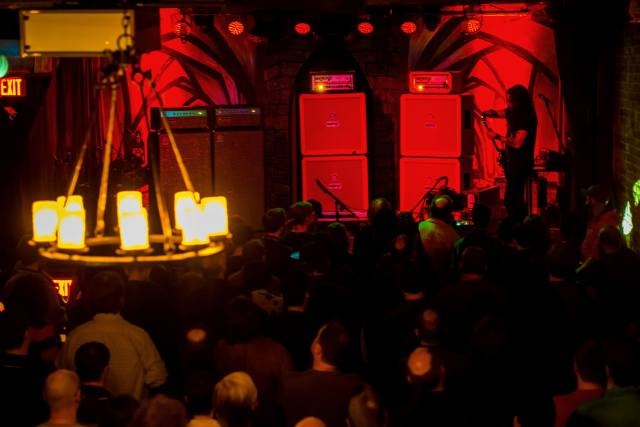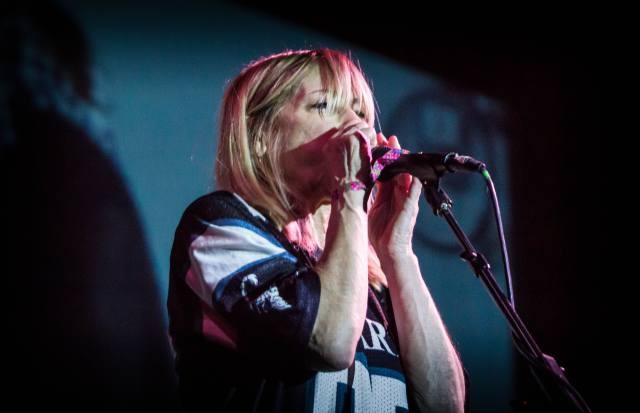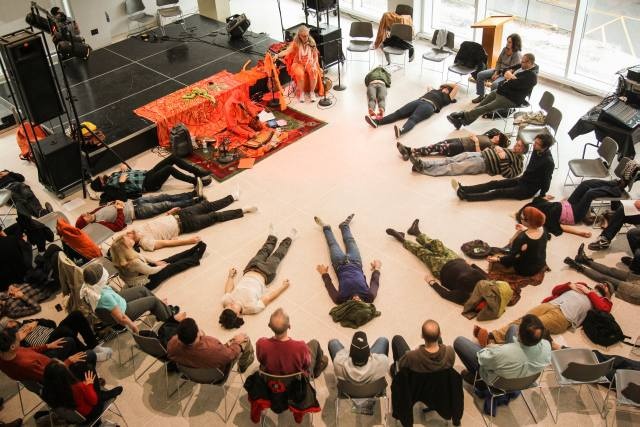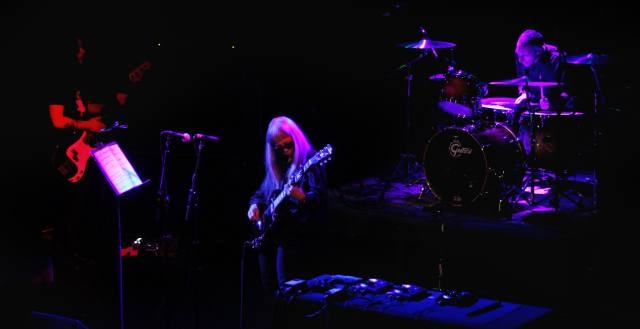Photo by Eric Smith
From the start, the Big Ears music festival has been an experiment. In 2009, AC Entertainment—the company partially responsible for Bonnaroo and Forecastle, and a slew of dates in clubs and concert halls throughout the Southeast—launched the three-day venture in the company’s hometown of Knoxville, Tennessee. Then, as it does now, the premise of Big Ears seemed like an unlikely proposition for success: With a smartly plucked cadre of modern composers and noise aggressors, electronic explorers and jazz outsiders, America would get its premier avant-garde event not in New York or Chicago, but in an orange-colored SEC football town with a population of less than 200,000.
Videos by VICE
The difficulty of the idea became immediate with the announcement of the second year’s lineup. The debut festival had included a mesmerizing Pauline Oliveros performance, two sets by The Necks, a Saturday afternoon piano recital by Philip Glass, and a Sunday night burst of bile from Michael Gira. But guest-curated by The National’s Bryce Dessner, Big Ears 2010 skewed toward the indie mainstream while trying its best to maintain its risky foothold. William Basinski opened for The Dirty Projectors, and an ecstatic version of Terry Riley’s In C followed a Vampire Weekend set on the festival’s biggest stage. “For one long weekend, can you truly balance the experimental and the accessible and let neither suffer?” Big Ears seemed to wonder that weekend in real-time. For the next four years, while the festival took an extended break, the answer seemed to be, flatly, “No.”
Then, last weekend, Big Ears returned to Knoxville with a renewed focus on the bleeding edges. It was as though the woeful absence reminded AC Entertainment owner Ashley Capps why he’d started this festival in the first place: Because, well, no one else really had. There were performances of Steve Reich works so loud that the rhythms danced new revelations and performances of Steve Reich works so delicate that you needed to stare ahead and strain your neck to catch every subtlety. Keiji Haino created the illusion of extreme chaos through a legendary sort of control (first with his daunting “power trio” Nazoranai, and then solo), and the Norwegian singer Susanna Wallumrød turned Thin Lizzy’s “Jailbreak” into a sublime, shy plea for the attention of any friend. To date, Big Ears has been an experiment with the boundaries and pragmatics of experimental music. This year, the festival’s third, the trial produced very little error.

Stephen O’Malley / Photo by Bill Foster
Big Ears smartly used a few recurring “stars” throughout the weekend, and they took various shapes. They were musicians like Stephen O’Malley, who performed three times, and Marc Ribot, who played with the mauling freak trio Ceramic Dog, solo and acoustic and finally with his reunited Latin outfit. They were ensembles, such as the ever-brilliant So Percussion, who played major roles every day, or the instrument-building, border-pressing Buke & Gase, who offered new work and built So Percussion’s new instruments, too. And they were composers, particularly Steve Reich, a selection of whose hallmark works were played daily and to rapt attention.
Perhaps the most important stars, though, were the weekend’s distinct but complementary musical approaches: You could submit to the trances of Laraaji’s sparkling zither melodies or O’Malley’s fastidiously controlled guitar tone, fed during his solo performance through four full stacks of guitar and bass amplifiers. Earth’s meditative doom-blues hymns provided a similar enticement, as did Reich’s Music for 18 Musicians, beautifully rendered by Ensemble Signal in the festival’s Sunday night finale. Or you could be over overcome by the paroxysmal: Haino’s Sunday set, for instance, offered a kind of career overview that built until it burst, with sheets of guitar noise sampled into static stabs that registered not as harsh noise but instead as the heaviest techno. And in front of slowly moving projections, Kim Gordon and Bill Nace, or Body/Head, wound through intuitive improvisations, his alternately meditative and menacing guitar linked to her late-night glossolalia. In a room of a few hundred, they seemed to be the only two speaking the same language, and the conversation was brilliant.

Kim Gordon / Photo by Scott Criss
Traces of both themes could be found across the festival, mixed in uneven proportions through the pop spirals of Son Lux and the stately tantrums of Low, in the transcendent and bracing guitars of Television and the patient brood of Helen Money’s amplified cello. For this revival, Big Ears tried less than ever to navigate the complicated relationship between the popular and the fringe. Aside from two Dean Wareham performances, legacy sets from Television and John Cale and the inclusion of a rather pat new piece from festival alumnus Dessner, there were almost no concessions to anything resembling the mainstream. That decision gave the festival an unerring steadfastness and vision, where every choice warranted a tag of curatorial. To wit, the Sunday afternoon succession of Haino, Lonnie Holley and Earth in the same small rock club might have looked strange on paper. But in person, they offered consecutively ravaging personal takes on melancholy—Haino’s defiant, Holley’s disappointed, Earth’s simply survivalist. It was a daylong seminar in art’s expressive deliverance, no matter the language or lack thereof, and it was worth the price of admission by itself.
As with any such large-scale gathering, there were misses: John Cale seemed to have taken the weekend’s experimental mantle too far, recasting the hits in arrangements that almost dared you to enjoy them without laughing. On the other hand, while Tim Hecker’s set of luminous noise was certainly loud and active, he now seems perfectly content to turn into static, or to make the Tim Hecker aesthetic not one of soft noise but of little evolution. He could have simply played a recording of his 2010 Big Ears set through the sound system, and no one would have questioned the decision. For a weekend that seemed so ripe with the possibility of reinvention, Hecker just floated by on a cloud of his own invention. That held for one of the festival’s rarest offerings, too. The Ethiopian keyboardist Hailu Mergia recently returned to the stage for the first time in 30 years with the help of Brooklyn band The Low Mentality. Despite his past of driving funk and psychedelic solo keyboard fantasies, Mergia’s fourth set with the new band, billed late on a Friday night in a club perfect for dancing, seemed like a complacent Sunday afternoon score, meant more for nodding along then participating bodies. But those were the aberrations that just proved a wonderful rule—that is, for the waking hours of an entire weekend, you could always find something that might just rattle your perception.

Laraaji / Photo by Scott Criss
Big Ears makes very few attempts to engage with the city itself as an active landscape or as more than a mere collection of beautiful theaters (the Tennessee, in particular, is a bejeweled site to behold) and multifunctional rock clubs. This year’s programming in the Knoxville Museum of Art, which required no festival pass and extended ample seating even to those without them, offered the exception. People crowded into a bright, high-windowed downstairs hall to hear an aching Saturday afternoon solo performance by Earth’s Dylan Carlson and brought scraps of material—a white Apple sticker, some Texas license plates, a large rectangular picture frame—for Holley to work into his extemporaneous sculptures. Reich himself performed “Clapping Music” there to begin the festival Friday night and participated in a question-and-answer session Sunday afternoon. Big Ears graciously turned the most intimate access to its ostensible headliner into a sort of gratis party favor, a gift to the city.
At the same time, there were no street parties or empty spaces converted into festival merchandising centers, no roving street bands or marketing teams wandering through downtown to give attendees samples or discounts. Very little, in other words, to suggest to casual observers that some of the world’s preeminent experimental music acts were performing in their midst. If you happened to be in Knoxville last weekend to run the city’s marathon or to attend its robotics convention, you might never have noticed the few thousand music fans crowded into specific zones. (You do have to wonder, though, what the laymen might have thought of Keiji Haino, walking through the streets of Manning town, his gray hair immaculately straight and his black sunglasses omnipresent.)

Keiji Haino and Nazoranai / Photo by Craig Nowicki-Barnes
Then again, that’s part of what makes Big Ears and its Knoxville setting so special: The city is big enough to absorb the influx but small enough to create a sense of community, so that the same wide-eyed, smiling guy that yells “I laugh at you” during Laraaji’s laughter workshop might be the same guy you see emerging stunned and silent from Electric Counterpoint. Or, after being rendered slack-jawed by So Percussion’s Saturday night reinvention of Drumming with the Nief-Norf percussion ensemble, you might stumble upon the group’s members in the streets on Sunday and thank them without feeling like some strange interloper. Knoxville somehow fosters the sort of community that Big Ears demands by simply being itself.
Big Ears created an ecosystem of those searching for a new experience, both during sets from iconoclasts that have become or are becoming icons and from a festival that does not toe the same lines as others, if it must toe any at all. After a four-year pause, the Big Ear’s chances to establish a truly grand American fringe exploration seem better than ever. It remains one of the country’s most audacious musical experiments, then—and this year, one of its most successful, too.
Grayson Currin likes his music weird. He’s on Twitter – @currincy
Noisey goes to a lot of festivals. Read about our trip to Savannah and two days of chaos at Burgerama.
More
From VICE
-

Screenshot: GSC Game World -

Screenshot: Bethesda Softworks -

Screenshot: Shaun Cichacki -

Screenshot: Ubisoft
